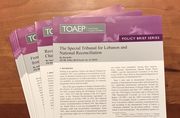Table of contents:
Element:
3. The perpetrator appropriated certain property.
ICTY
The Mucić et al. ("Čelebići") Trial Chamber precised:
"it is to be observed that the prohibition against the unjustified appropriation of public and private enemy property is general in scope, and extends both to acts of looting committed by individual soldiers for their private gain, and to the organized seizure of property undertaken within the framework of a systematic economic exploitation of occupied territory."[1]
SCSL
As stated by the Trial Chamber in Brima et al.
"Having carefully examined all relevant sources, the Trial Chamber is of the opinion that the inclusion of 'burning' in the crime of 'pillage', as suggested by the Prosecution, is untenable. First, a review of military manuals shows that most countries do not regard the destruction of enemy property as pillage. Second, the jurisprudence is unambiguous in requiring that the property be appropriated, an element which is not satisfied in the event that property is burned and destroyed. The Rome Statute also makes a distinction between appropriation and destruction of property."[2]
According to the Appeals Chamber in Fofana and Kondewa,
"[T]he prohibitions against pillage an wanton destruction have been considered distinct in the conventional law prior to time relevant to this case. The Appeals Chamber notes that the interpretation of pillage at other international courts and State practice also demonstrate that pillage relates specifically to unlawful appropriation and therefore could not include acts of destruction."[3]
The Appeals Chamber also added that:
"Taking into consideration the definition of pillage applied by the ICTY and the ICTR which logically excludes acts of destruction, the distinction between the prohibitions against pillage and destruction not justified by military necessities, which is preserved throughout applicable conventional international law and the drafting history of the Statute of the Special Court, the Appeals Chamber finds that a necessary element of the crime of pillage is the unlawful appropriation of property. Consequently, burning and other acts of destruction of property not amounting to appropriation as a matter of law, cannot constitute pillage under international criminal law."[4]
3.1. The act of appropriation.
ICC
The Pre-Trial Chamber in Katanga and Chui noted that:
"Like the war crime of destruction of property under article 8(2)(b)(xiii), the war crime of pillaging under article 8(2)(b)(xvi) of the Statute requires that the property subject to the offence belongs to an 'enemy' or 'hostile' party to the conflict. Therefore, the pillaged property - whether moveable or immoveable, private or public - must belong to individuals or entities who are aligned with or whose allegiance is to a party to the conflict who is adverse or hostile to the perpetrator.
"Whereas the war crime of destruction of property under article 8(2)(b)(xiii) of the Statute can take place before the destroyed property has fallen into the hands of the party to the conflict to which the perpetrator belongs, the war crime of pillaging occurs when the enemy's property has come under the control of the perpetrator. Only then is the perpetrator in a position to 'appropriate' such property."[5]
ICTY
The Mucić et al. ("Čelebići") Trial Chamber held that, for the purposes of article 3(e) of the ICTY Statute, "plunder" encompasses:
"all forms of unlawful appropriation of property in armed conflict for which individual responsibility attaches under international law, including those acts traditionally described as 'pillage'."[6]
The Trial Chamber in the Naletilić and Martinović ("Tuta and Štela") Case observed that the term "plunder" is:
"general in scope, comprising not only large-scale seizures of property within the framework of systematic economic exploitations of occupied territory but also acts of appropriation committed by individual soldiers for their private gain."[7]
The Chamber further noted that the Commentary on the Additional Protocols:
"clarifies that 'pillage' is prohibited whether organised or resulting from 'isolated acts or indiscipline'."[8]
3.1.1. Evidence of the organized appropriation of property.
3.1.2. Evidence of isolated acts of theft or plunder.
De minimis requirement
ICTY
In the Tadić Appeals Decision on Jurisdiction, the Appeals Chamber stated that:
"the violation must be 'serious,' that is to say, it must constitute a breach of a rule protecting important values, and the breach must involve grave consequences for the victim. Thus, for instance, the fact of a combatant simply appropriating a loaf of bread in an occupied village would not amount to a 'serious violation of international humanitarian law' although it may be regarded as falling foul of the basic principle laid down in Article 46, paragraph 1, of the Hague Regulations (and the corresponding rule of customary international law) whereby 'private property must be respected' by any army occupying an enemy territory"[9]
In the first trial Judgment issued on the matter, the Mucić et al. ("Čelebići") Trial Chamber dismissed one count of plunder on the ground that:
"the evidence [...] fails to demonstrate that any property taken from the detainees in the Čelebići prison-camp was of sufficient monetary value for its unlawful appropriation to involve grave consequences for the victims."[10]
"The Trial Chamber notes that it is in full agreement with the Appeals Chamber that in order for a violation of international humanitarian law to be "serious" within the meaning of the Statute, two elements must be fulfilled. First, the alleged offence must be one which constitutes a breach of a rule protecting important values. Secondly, it must also be one which involves grave consequences for the victim. As set out in greater detail above, it is the Trial Chamber's view that the prohibition against unjustified appropriation of private or public property constitutes a rule protecting important values. However, even when considered in the light most favourable to the Prosecution, the evidence before the Trial Chamber fails to demonstrate that any property taken from the detainees in the Čelebići prison-camp was of sufficient monetary value for its unlawful appropriation to involve grave consequences for the victims. Accordingly, it is the Trial Chamber's opinion that the offences, as alleged, cannot be considered to constitute such serious violations of international humanitarian law that they fall within the subject matter jurisdiction of the International Tribunal pursuant to Article 1 of the Statute. Count 49 of the Indictment is thus dismissed."[11]
On the opposite, in Jelisić, the Trial Chamber decided:
"The factual basis attached to the guilty plea indicates that the accused stole money, watches, jewellery and other valuables from the detainees upon their arrival at Luka camp by threatening those who did not hand over all their possessions with death. The accused was sometimes accompanied by guards or Monika but he mostly acted alone. The Trial Chamber holds that these elements are sufficient to confirm the guilt of the accused on the charge of plunder."[12]
In the same way, the Naletilić and Martinović ("Tuta and Štela") Trial Chamber recalled:
"The Kunarac Trial Chamber held that the word 'plunder' contained in the Statute would require a theft at least committed by at least one person; an interpretation apparently supported by the fact that "pillage" is often used as a synonym of 'plunder'. The Chamber concurs with the legal findings in the Kunarac Decision of Motion for Acquittal if read to mean that as far as the jurisdiction of the Tribunal is concerned, plunder must involve grave consequences for the victims, thus amounting to a 'serious violation'."[13]
The Martinović and Naletilić ("Tuta and Štela") Trial Chamber specifically found:
"Regarding the other plunder incidents, Vinko Martinovi} was present on some occasions when his soldiers committed acts of looting; sometimes explicitly organising how plunder should take place. On other occasions, apartments were looted by soldiers in areas under his responsibility and by soldiers subordinate to Martinovi} himself, even if he was not present on the spot. The evidence shows that Vinko Martinovi} knew that plunder was occurring in several instances during this period and failed to take the necessary and reasonable measures to prevent it or to punish the perpetrators. The Chamber finds him responsible of plunder in locations other than the DUM neighbourhood under Articles 3(e) and 7(3) of the Statute."[14]
SCSL
As noted by the Trial Chamber in Sesay et al.
"Although proof of pillage under international law does not require the items appropriated to be of significant value, we recall that the jurisdiction of the Court may only be exercised in respect of serious violations. We are of the opinion that to determine the seriousness of the violation, reference may be made to the nature, scope, dimension, or the collective scale of the looting, for instance by considering the number of people from whom property is appropriated."[15]
Footnotes:
[1] ICTY, Mucić et al. ("Čelebići") Trial Judgment, 16 November 1998, para. 590.
[2] SCSL, Brima et al. Trial Judgment, 20 June 2007, para. 757 (footnotes omitted).
[3] SCSL, Fofana and Kondewa Appeal judgment, 28 May 2009, para. 400.
[4] SCSL, Fofana and Kondewa Appeal judgment, 28 May 2009, para. 409.
[5] ICC, Katanga and Chui Decision on the confirmation of charges, 30 September 2008, paras. 329-330.
[6] ICTY, Mucić et al. ("Čelebići") Trial Judgment, 16 November 1998, para. 591. Also, see ICTY, Kordić and Čerkez Trial Judgment, 26 February 2001, para. 353; ICTY, Blaškić Trial Judgment, 3 March 2000, para. 181; ICTY, Jelisić Trial Judgment, 14 December 1999, para. 48.
[7] ICTY, Prosecutor v. Naletilić and Martinović ("Tuta and Štela"), "Judgment", IT-98-34-T, 31 March 2003, para. 612.
[8] ICTY, Prosecutor v. Naletilić and Martinović ("Tuta and Štela"), "Judgment", IT-98-34-T, 31 March 2003, para. 612.
[9] ICTY, Tadić, Decision on the Defence Motion for Interlocutory Appeal on Jurisdiction, 2 October 1995, para. 94: .
[10] ICTY, Mucić et al. ("Čelebići") Trial Judgment, 16 November 1998, para. 1154 (emphasis added).
[11] ICTY, Mucić et al. ("Čelebići") Trial Judgment, 16 November 1998, para. 1154.
[12] ICTY, Jelisić Trial Judgment, 14 December 1999, para. 49 (footnotes omitted).
[13] ICTY, Prosecutor v. Naletilić and Martinović ("Tuta and Štela"), "Judgment", IT-98-34-T, 31 March 2003, para. 613. Also see ICTY, Prosecutor v. Kunarac, "Decision on Motion for Acquittal", IT-96-23-T & IT-96-23/1-T, 3 July 2000, paras. 15-16.
[14] ICTY, Prosecutor v. Naletilić and Martinović ("Tuta and Štela"), "Judgment", IT-98-34-T, 31 March 2003, para. 628 (footnotes omitted).
[15] SCSL, Sesay et al. Trial Judgment, 2 March 2009, para. 1027.







